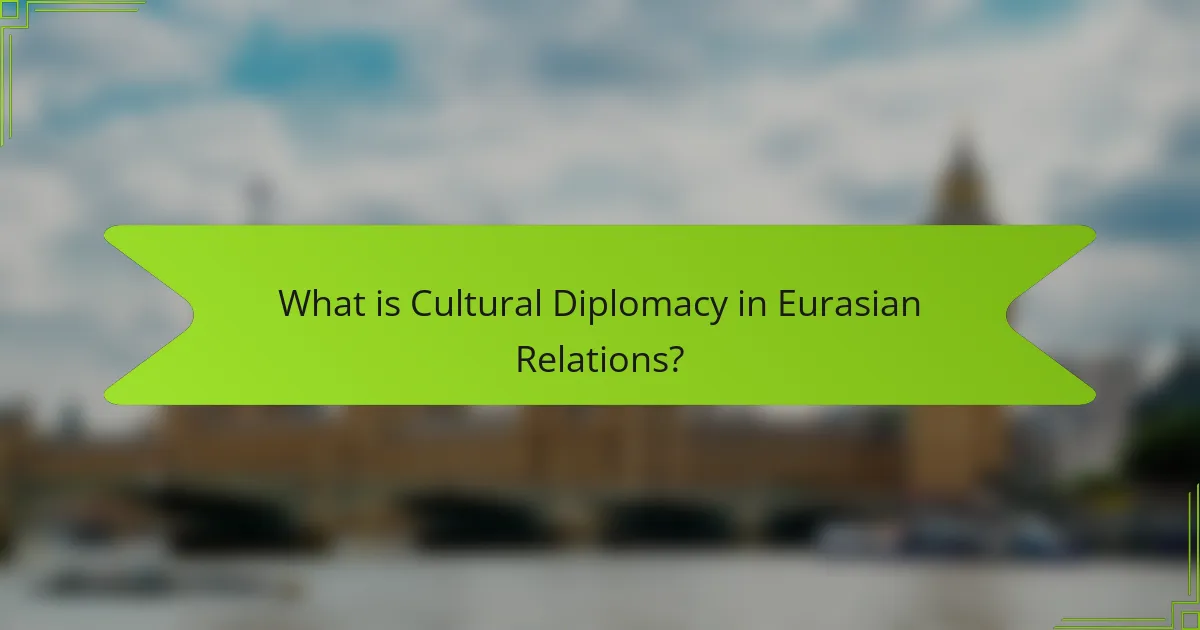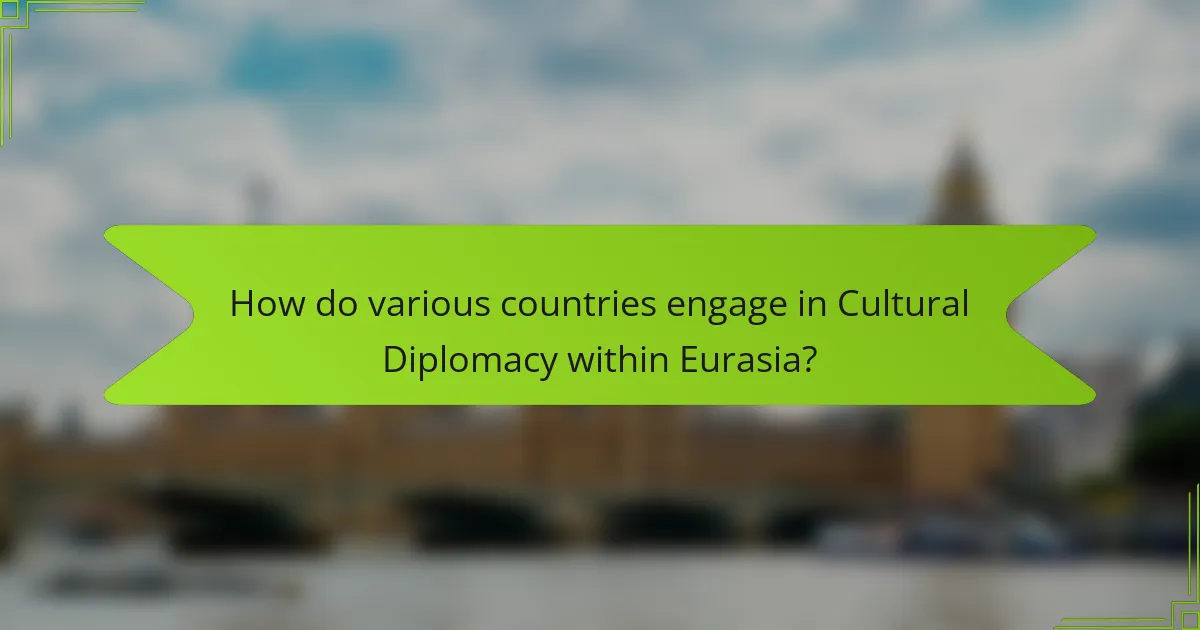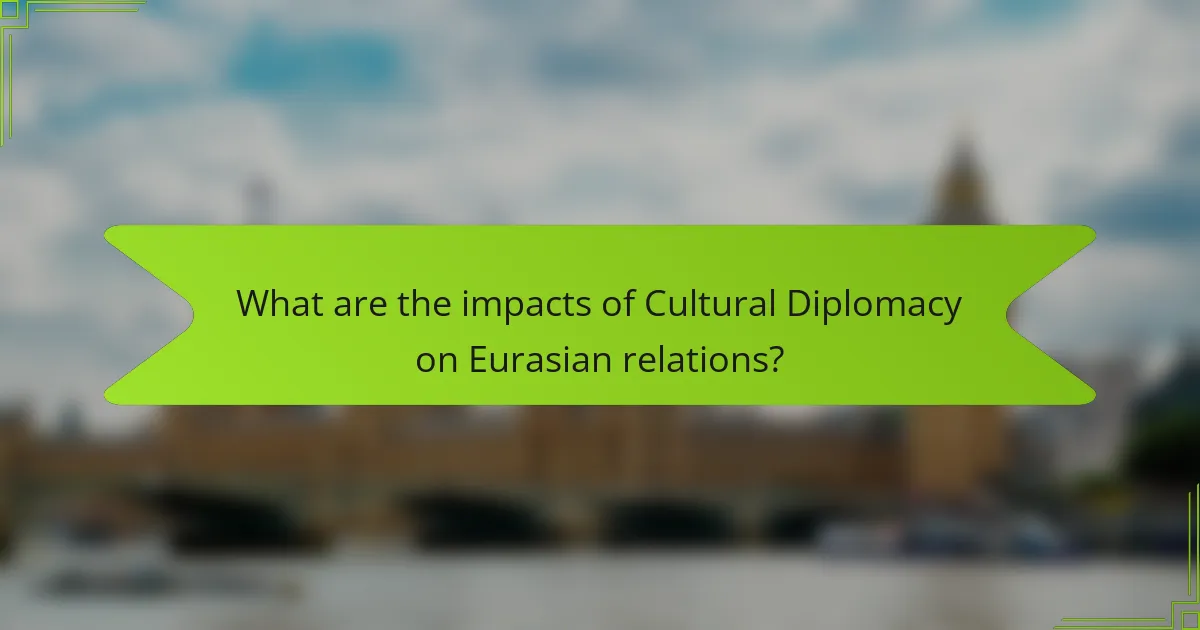Cultural diplomacy in Eurasian relations involves the strategic use of cultural exchanges to enhance mutual understanding among countries in the region. This approach leverages art, education, and shared heritage to strengthen diplomatic ties and promote soft power. Key initiatives include cultural festivals, academic partnerships, and language programs, which facilitate dialogue and cooperation. Countries such as Russia, China, and Turkey actively engage in cultural diplomacy to mitigate political tensions and foster economic collaboration. These efforts not only build trust but also contribute to regional stability and peacebuilding.

What is Cultural Diplomacy in Eurasian Relations?
Cultural diplomacy in Eurasian relations refers to the use of cultural exchanges and initiatives to foster mutual understanding among countries in the Eurasian region. It aims to strengthen ties through art, education, and shared cultural heritage. Such diplomacy enhances soft power by promoting dialogue and collaboration. Countries engage in cultural diplomacy to address political tensions and improve bilateral relations. For instance, initiatives like cultural festivals and academic partnerships exemplify this approach. These efforts often lead to increased tourism and economic cooperation. Cultural diplomacy also helps in building trust and mitigating conflicts among nations.
How does Cultural Diplomacy influence relationships between Eurasian countries?
Cultural diplomacy significantly influences relationships between Eurasian countries by fostering mutual understanding and collaboration. It promotes cultural exchanges, which enhance people-to-people connections. These connections can lead to increased trust and cooperation in political and economic matters. For example, initiatives like cultural festivals and educational programs create platforms for dialogue. Such interactions help to mitigate historical tensions and stereotypes. In addition, cultural diplomacy often involves art, music, and literature, which can transcend language barriers. By highlighting shared cultural heritage, countries can strengthen their ties. This approach has been evident in projects like the Silk Road Economic Belt, which emphasizes cultural collaboration alongside trade.
What are the historical contexts of Cultural Diplomacy in Eurasia?
Cultural diplomacy in Eurasia has evolved through various historical contexts influenced by political, social, and economic factors. The Silk Road, active from the 2nd century BCE to the 14th century CE, facilitated cultural exchanges between East and West. Empires such as the Mongol Empire promoted cultural integration across vast territories. The Cold War era saw cultural diplomacy as a tool for ideological influence, with the USSR and the USA leveraging cultural programs to gain allies. Post-Soviet states have used cultural diplomacy to foster regional cooperation and identity. Recent initiatives focus on soft power through arts and education to strengthen ties among Eurasian nations. These historical contexts illustrate the dynamic role of cultural diplomacy in shaping relationships in Eurasia.
How have cultural exchanges shaped diplomatic ties in the region?
Cultural exchanges have significantly shaped diplomatic ties in the region by fostering mutual understanding and cooperation. These exchanges include art exhibitions, educational programs, and cultural festivals. They create platforms for dialogue among nations. For example, joint cultural projects have led to increased people-to-people connections. Such interactions often result in stronger political alliances. Historical instances show that cultural diplomacy has successfully resolved conflicts. The Silk Road historically facilitated cultural exchange, enhancing trade relations. Recent initiatives continue this trend, promoting peace and stability through shared cultural heritage.
What are the key components of Cultural Diplomacy in Eurasian Relations?
The key components of Cultural Diplomacy in Eurasian Relations include exchange programs, cultural events, and collaborative projects. Exchange programs facilitate mutual understanding through student and professional exchanges. Cultural events, such as festivals and exhibitions, showcase diverse traditions and foster connections. Collaborative projects often involve art, music, and literature, promoting shared values and narratives. These components aim to enhance dialogue and cooperation among Eurasian countries. They contribute to building trust and reducing tensions in the region. Cultural diplomacy efforts are supported by governmental and non-governmental organizations to maximize impact.
Which cultural practices are most commonly used in diplomatic efforts?
Cultural practices commonly used in diplomatic efforts include art exchanges, educational programs, and cultural festivals. Art exchanges facilitate mutual understanding through shared artistic expressions. Educational programs enable student and professional exchanges, fostering long-term relationships. Cultural festivals celebrate traditions and heritage, promoting goodwill among nations. These practices enhance soft power and build trust between countries. Historical examples include the U.S.-China cultural exchanges initiated in the 1970s. These initiatives have led to improved diplomatic relations and collaboration.
How do art, music, and literature contribute to Cultural Diplomacy?
Art, music, and literature serve as vital tools in cultural diplomacy. They foster mutual understanding between nations. Artistic expressions convey cultural narratives that transcend language barriers. Music can evoke emotions and create shared experiences among diverse audiences. Literature offers insights into a nation’s values and historical context. These forms of expression facilitate dialogue and collaboration. For instance, international festivals showcase cultural heritage, promoting goodwill. Studies show that cultural exchanges enhance diplomatic relations by building trust. Overall, art, music, and literature enrich cultural diplomacy by creating connections.
What challenges does Cultural Diplomacy face in Eurasian Relations?
Cultural diplomacy faces several challenges in Eurasian relations. These challenges include political tensions among nations in the region. Historical conflicts can hinder collaborative cultural initiatives. Differing national narratives complicate mutual understanding. Language barriers also obstruct effective communication between cultures. Economic disparities affect the resources available for cultural exchanges. Furthermore, varying levels of openness to foreign influence can restrict engagement. These factors collectively limit the potential for successful cultural diplomacy in Eurasia.
How do political tensions affect cultural exchanges?
Political tensions significantly hinder cultural exchanges. When nations experience conflict, they often impose restrictions on travel, communication, and collaboration. For example, during the Cold War, cultural exchanges between the United States and the Soviet Union were severely limited. This resulted in reduced opportunities for artists, scholars, and citizens to engage with one another. Additionally, political propaganda can overshadow genuine cultural initiatives. In such environments, mutual understanding and appreciation are diminished. Historical instances show that cultural diplomacy is less effective when political relations are strained. Thus, political tensions directly obstruct the flow of cultural interactions.
What role does public perception play in Cultural Diplomacy initiatives?
Public perception significantly influences Cultural Diplomacy initiatives. It shapes how cultural exchanges are received by different audiences. Positive public perception can enhance the effectiveness of diplomatic efforts. It fosters goodwill and encourages collaboration between nations. Conversely, negative perceptions can hinder these initiatives. They may lead to resistance or backlash against cultural programs. Research indicates that public opinion is crucial for the success of diplomacy. For instance, the Pew Research Center highlights the impact of favorable views on international relations. Thus, understanding and addressing public perception is essential for successful Cultural Diplomacy.

How do various countries engage in Cultural Diplomacy within Eurasia?
Various countries engage in cultural diplomacy within Eurasia through initiatives that promote cultural exchange and mutual understanding. Countries like Russia, China, and Turkey utilize cultural festivals and educational programs to foster relationships. For instance, Russia hosts the “Russian Cultural Days” in several Eurasian nations to showcase its arts and traditions. China promotes the “Confucius Institute” network to teach the Chinese language and culture across the region. Turkey engages through its “Turkish Cultural Centers,” which facilitate cultural activities and language courses. These efforts aim to enhance soft power and strengthen diplomatic ties. Such initiatives are supported by historical ties and shared cultural heritage among these nations.
What strategies do countries employ for effective Cultural Diplomacy?
Countries employ various strategies for effective cultural diplomacy. These strategies include promoting cultural exchanges, establishing partnerships with cultural institutions, and supporting international cultural events. Cultural exchanges allow for direct interaction between peoples, fostering mutual understanding. Partnerships with cultural institutions enhance collaboration and resource sharing. Supporting international cultural events, such as festivals and exhibitions, showcases a country’s heritage on a global stage.
For example, the United States has utilized the Fulbright Program to promote educational exchanges. Similarly, China’s Confucius Institutes aim to teach Chinese language and culture worldwide. These initiatives demonstrate a commitment to fostering relationships through cultural understanding.
How do governmental and non-governmental organizations collaborate in this space?
Governmental and non-governmental organizations collaborate in cultural diplomacy through partnerships, joint initiatives, and resource sharing. These collaborations often focus on promoting cultural exchange and understanding among Eurasian nations. For instance, governmental bodies may provide funding and policy support, while NGOs can facilitate grassroots engagement and cultural programs. Collaborative projects can include art exhibitions, educational exchanges, and cultural festivals that highlight shared heritage. Research shows that such partnerships enhance mutual respect and foster dialogue, ultimately contributing to regional stability and cooperation.
What are the roles of cultural ambassadors and attachés?
Cultural ambassadors and attachés promote cultural understanding and cooperation between nations. They facilitate cultural exchanges, organize events, and support artistic collaborations. These roles help to strengthen diplomatic ties and foster mutual respect. Cultural ambassadors often represent their country’s cultural interests abroad. Attachés typically work within embassies to enhance cultural diplomacy efforts. They may also provide insights into local cultural dynamics. Their activities can include educational programs, exhibitions, and performances. This engagement contributes to soft power and international relations.
How do international events and festivals promote Cultural Diplomacy?
International events and festivals promote cultural diplomacy by facilitating cross-cultural exchanges. These gatherings enable countries to showcase their traditions, arts, and values. They create platforms for dialogue and mutual understanding among diverse populations. For instance, events like the Cannes Film Festival highlight films from various cultures, fostering global appreciation. Festivals often feature collaborative performances, encouraging interaction between artists from different nations. This interaction helps break down stereotypes and build relationships. Furthermore, cultural diplomacy through festivals can enhance soft power, as nations gain influence through cultural appeal. Events like the Edinburgh Festival Fringe attract international audiences, showcasing the richness of global cultures. This exchange ultimately strengthens international ties and promotes peace.
What are some notable cultural events in Eurasia that foster diplomatic ties?
Notable cultural events in Eurasia that foster diplomatic ties include the Eurasian Economic Forum and the Silk Road Cultural Festival. The Eurasian Economic Forum promotes economic cooperation among member states. It features discussions on trade, investment, and cultural exchange. The Silk Road Cultural Festival celebrates the historical Silk Road’s cultural heritage. It showcases art, music, and traditions from various Eurasian countries. Events like these enhance mutual understanding and strengthen diplomatic relationships. They facilitate collaboration in cultural, economic, and political spheres. Cultural diplomacy is crucial for fostering peace and cooperation in the region.
How do these events impact public diplomacy efforts?
Events significantly impact public diplomacy efforts by shaping perceptions and influencing narratives. These events can enhance or hinder a nation’s image abroad. For example, cultural exchanges during international festivals foster goodwill and mutual understanding. Conversely, political unrest can damage diplomatic relations and public trust. A 2021 study by the Pew Research Center found that positive cultural interactions improve public opinion of foreign nations. Additionally, media coverage of events plays a crucial role in framing the narrative. Effective public diplomacy relies on the ability to navigate these dynamics strategically.

What are the impacts of Cultural Diplomacy on Eurasian relations?
Cultural diplomacy significantly impacts Eurasian relations by fostering mutual understanding and cooperation. It enhances soft power among countries in the region. For instance, cultural exchanges promote dialogue and reduce tensions. Events like art exhibitions and music festivals strengthen ties between nations. Collaborative projects in education and research create lasting partnerships. Countries such as Russia and China use cultural diplomacy to expand their influence. This approach helps to counterbalance political and economic rivalries. Overall, cultural diplomacy serves as a tool for peacebuilding and regional stability.
How does Cultural Diplomacy contribute to peace-building in the region?
Cultural diplomacy contributes to peace-building in the region by fostering mutual understanding and respect among diverse cultures. It facilitates dialogue between nations, reducing tensions through shared cultural experiences. Programs such as art exchanges and educational initiatives promote collaboration and empathy. Historical examples include the use of cultural events to bridge divides during conflicts. These initiatives create a platform for addressing grievances and building trust. Research indicates that cultural diplomacy can lead to sustained peace by enhancing interpersonal connections. This approach is essential in regions with complex historical relationships, as it addresses root causes of conflict.
What examples exist of successful Cultural Diplomacy leading to conflict resolution?
Successful cultural diplomacy examples leading to conflict resolution include the 1972 Ping Pong Diplomacy between the United States and China. This initiative helped ease tensions and opened diplomatic relations. Another example is the role of cultural exchanges in the 1990s between South Korea and North Korea. These exchanges fostered dialogue and reduced hostilities. The Helsinki Accords of 1975 also exemplified cultural diplomacy. They facilitated discussions on human rights, which contributed to easing Cold War tensions. These instances demonstrate how cultural engagement can lead to significant conflict resolution outcomes.
How can Cultural Diplomacy enhance mutual understanding among diverse cultures?
Cultural diplomacy enhances mutual understanding among diverse cultures by promoting dialogue and exchange. It facilitates interactions through art, education, and cultural events. These exchanges allow individuals to experience different perspectives and traditions. For example, cultural festivals can showcase traditional music and cuisine. Such events create opportunities for personal connections and shared experiences. Research indicates that countries engaging in cultural diplomacy report improved international relations. According to a study by the British Council, cultural engagement leads to increased trust and cooperation among nations. This process fosters empathy and reduces stereotypes, ultimately bridging cultural divides.
What best practices can be adopted for effective Cultural Diplomacy in Eurasia?
Effective cultural diplomacy in Eurasia can be achieved through several best practices. First, fostering mutual understanding is essential. This can be accomplished by organizing cultural exchange programs that showcase diverse traditions and practices. Second, collaboration with local artists and cultural institutions enhances authenticity. Engaging local voices ensures that initiatives resonate with the community. Third, utilizing digital platforms can broaden outreach. Online campaigns can connect diverse audiences across vast geographical areas. Fourth, promoting language learning initiatives strengthens interpersonal connections. Language skills facilitate deeper engagement and appreciation of cultural nuances. Fifth, addressing historical contexts is crucial. Acknowledging past relations helps build trust and credibility. Lastly, continuous evaluation of cultural programs is necessary. Feedback mechanisms can guide improvements and ensure relevance. These practices are supported by successful case studies in various Eurasian nations, demonstrating their effectiveness in enhancing diplomatic relations.
How can countries measure the success of their Cultural Diplomacy initiatives?
Countries can measure the success of their Cultural Diplomacy initiatives through various quantitative and qualitative metrics. Surveys can gauge public perception and awareness of cultural initiatives. Participation rates in cultural events indicate engagement levels. Media coverage analysis can reflect the visibility of cultural diplomacy efforts. Partnerships with local organizations can demonstrate collaborative success. Academic exchanges and scholarships can be tracked for their impact on international relationships. Long-term relationships and collaborations formed as a result of cultural diplomacy serve as indicators of effectiveness. Additionally, the establishment of cultural centers abroad can be evaluated for their outreach and influence. These metrics provide a comprehensive overview of the impact and effectiveness of cultural diplomacy initiatives.
What recommendations exist for improving Cultural Diplomacy efforts in the region?
Enhancing Cultural Diplomacy efforts in the region requires strategic collaboration among nations. Establishing joint cultural programs can foster mutual understanding. Promoting educational exchanges between universities will build long-lasting relationships. Supporting local arts and cultural festivals can showcase diverse heritages. Utilizing digital platforms for cultural outreach can expand audience engagement. Encouraging government support for cultural initiatives will solidify commitment. Strengthening partnerships with NGOs can amplify outreach and impact. Investing in training for cultural diplomats can improve effectiveness in communication.
Cultural diplomacy in Eurasian relations encompasses the use of cultural exchanges and initiatives to enhance mutual understanding among countries in the region. This article explores the influence of cultural diplomacy on diplomatic ties, historical contexts, and the key components that facilitate collaboration, such as art, education, and shared heritage. It also addresses the challenges faced, including political tensions and public perception, while highlighting successful cultural initiatives and strategies employed by various countries. Additionally, the article discusses the role of international events in promoting cultural diplomacy and their impact on peace-building and conflict resolution in Eurasia.